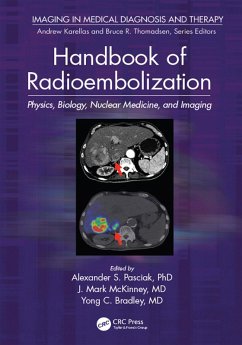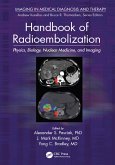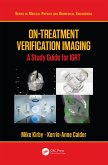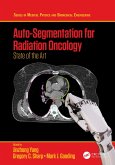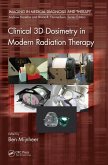Handbook of Radioembolization (eBook, PDF)
Physics, Biology, Nuclear Medicine, and Imaging
Redaktion: Pasciak, Alexander S.; McKinney MD., J. Mark; Bradley MD., Yong


Alle Infos zum eBook verschenken

Handbook of Radioembolization (eBook, PDF)
Physics, Biology, Nuclear Medicine, and Imaging
Redaktion: Pasciak, Alexander S.; McKinney MD., J. Mark; Bradley MD., Yong
- Format: PDF
- Merkliste
- Auf die Merkliste
- Bewerten Bewerten
- Teilen
- Produkt teilen
- Produkterinnerung
- Produkterinnerung

Hier können Sie sich einloggen

Bitte loggen Sie sich zunächst in Ihr Kundenkonto ein oder registrieren Sie sich bei bücher.de, um das eBook-Abo tolino select nutzen zu können.
Radioembolization is now the preferred treatment for both primary and secondary liver cancer. This handbook addresses the radiation biology, physics, nuclear medicine, and imaging for radioembolization using Yttrium-90 (90Y) microspheres, in addition to discussing aspects related to interventional radiology. The contents reflect new on-label hepatic treatment indications, both in the US and worldwide, as well as dose-response relationships associated with radioembolization and the utility of adjuvant radioembolization and systemic chemotherapy.
- Geräte: PC
- mit Kopierschutz
- eBook Hilfe
- Größe: 66.96MB
![Handbook of Radioembolization (eBook, ePUB) Handbook of Radioembolization (eBook, ePUB)]() Handbook of Radioembolization (eBook, ePUB)46,95 €
Handbook of Radioembolization (eBook, ePUB)46,95 €![On-Treatment Verification Imaging (eBook, PDF) On-Treatment Verification Imaging (eBook, PDF)]() Mike KirbyOn-Treatment Verification Imaging (eBook, PDF)46,95 €
Mike KirbyOn-Treatment Verification Imaging (eBook, PDF)46,95 €![The Physics of CT Dosimetry (eBook, PDF) The Physics of CT Dosimetry (eBook, PDF)]() Robert L. DixonThe Physics of CT Dosimetry (eBook, PDF)46,95 €
Robert L. DixonThe Physics of CT Dosimetry (eBook, PDF)46,95 €![Auto-Segmentation for Radiation Oncology (eBook, PDF) Auto-Segmentation for Radiation Oncology (eBook, PDF)]() Auto-Segmentation for Radiation Oncology (eBook, PDF)46,95 €
Auto-Segmentation for Radiation Oncology (eBook, PDF)46,95 €![Clinical 3D Dosimetry in Modern Radiation Therapy (eBook, PDF) Clinical 3D Dosimetry in Modern Radiation Therapy (eBook, PDF)]() Clinical 3D Dosimetry in Modern Radiation Therapy (eBook, PDF)46,95 €
Clinical 3D Dosimetry in Modern Radiation Therapy (eBook, PDF)46,95 €![Big Data in Radiation Oncology (eBook, PDF) Big Data in Radiation Oncology (eBook, PDF)]() Big Data in Radiation Oncology (eBook, PDF)55,95 €
Big Data in Radiation Oncology (eBook, PDF)55,95 €![A Brief Survey of Quantitative EEG (eBook, PDF) A Brief Survey of Quantitative EEG (eBook, PDF)]() Kaushik MajumdarA Brief Survey of Quantitative EEG (eBook, PDF)143,95 €
Kaushik MajumdarA Brief Survey of Quantitative EEG (eBook, PDF)143,95 €-
-
-
Dieser Download kann aus rechtlichen Gründen nur mit Rechnungsadresse in A, B, BG, CY, CZ, D, DK, EW, E, FIN, F, GR, HR, H, IRL, I, LT, L, LR, M, NL, PL, P, R, S, SLO, SK ausgeliefert werden.
- Produktdetails
- Verlag: Taylor & Francis
- Seitenzahl: 348
- Erscheinungstermin: 3. November 2016
- Englisch
- ISBN-13: 9781498742023
- Artikelnr.: 47134600
- Verlag: Taylor & Francis
- Seitenzahl: 348
- Erscheinungstermin: 3. November 2016
- Englisch
- ISBN-13: 9781498742023
- Artikelnr.: 47134600
non-resectable liver cancer. PATIENT SELECTION AND TREATMENT PLANNING.
Treatment options for patients with primary and secondary liver cancer: An
overview of invasive, minimally invasive and non-invasive techniques.
Treatment planning part I: Vascular considerations. Treatment planning part
II: Procedure simulation using 99mTc-MAA. Treatment planning part III:
Dosimetric considerations in conventional lobar therapy. Treatment planning
part IV: Radioembolization in segmentectomy, lobectomy and future liver
remnant hypertrophy. TREATING PATIENTS WITH RADIOEMBOLIZATION. Radiation
safety concerns associated with preparing the dose, treating and releasing
the patient and managing radioactive waste. The radiation biology of
radioembolization. Glass and resin microspheres: An analysis on a
microscopic and macroscopic level. FOLLOWING PATIENTS TREATED WITH
RADIOEMBOLIZATION. Quantitative post-radioembolization imaging using
Bremsstrahlung SPECT. Quantitative post-radioembolization imaging using
PET/CT. Image-based 3-dimensional dosimetry following radioembolization.
Diagnostic reporting using post-radioembolization imaging. Using
post-treatment imaging in the medical management of patients treated with
radioembolization. The potential utility of serial therapy in
radioembolization: A radiation biology analysis. NEW HORIZONS. Future
directions in radioembolization for intrahepatic and extrahepatic treatment
of disease
non-resectable liver cancer. PATIENT SELECTION AND TREATMENT PLANNING.
Treatment options for patients with primary and secondary liver cancer: An
overview of invasive, minimally invasive and non-invasive techniques.
Treatment planning part I: Vascular considerations. Treatment planning part
II: Procedure simulation using 99mTc-MAA. Treatment planning part III:
Dosimetric considerations in conventional lobar therapy. Treatment planning
part IV: Radioembolization in segmentectomy, lobectomy and future liver
remnant hypertrophy. TREATING PATIENTS WITH RADIOEMBOLIZATION. Radiation
safety concerns associated with preparing the dose, treating and releasing
the patient and managing radioactive waste. The radiation biology of
radioembolization. Glass and resin microspheres: An analysis on a
microscopic and macroscopic level. FOLLOWING PATIENTS TREATED WITH
RADIOEMBOLIZATION. Quantitative post-radioembolization imaging using
Bremsstrahlung SPECT. Quantitative post-radioembolization imaging using
PET/CT. Image-based 3-dimensional dosimetry following radioembolization.
Diagnostic reporting using post-radioembolization imaging. Using
post-treatment imaging in the medical management of patients treated with
radioembolization. The potential utility of serial therapy in
radioembolization: A radiation biology analysis. NEW HORIZONS. Future
directions in radioembolization for intrahepatic and extrahepatic treatment
of disease
